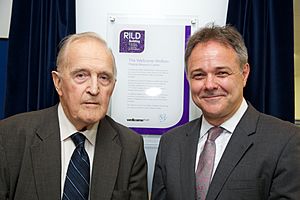David Weatherall facts for kids
Quick facts for kids
David Weatherall
|
|
|---|---|

Weatherall (left) and Jeremy Farrar (right) in 2014
|
|
| Born |
David John Weatherall
9 March 1933 Liverpool, England, United Kingdom
|
| Died | 8 December 2018 (aged 85) Oxford, England, United Kingdom
|
| Alma mater | University of Liverpool |
| Awards |
|
| Scientific career | |
| Institutions |
|
Sir David John Weatherall (born March 9, 1933 – died December 8, 2018) was a famous British doctor and scientist. He studied how our bodies work at a tiny level. He was especially interested in blood and diseases related to it.
Contents
Becoming a Doctor
David Weatherall was born in a city called Liverpool, England. He went to Calday Grange Grammar School. After that, he studied medicine at the University of Liverpool. He finished medical school in 1956.
Army Service and a Big Discovery
After medical school, David joined the Army for two years. He was sent to Singapore. While there, he treated a young girl who had a serious blood disease called thalassemia. This experience made him very interested in this disease. He even used car batteries to do early blood tests!
A Career in Science
When he left the army, David went to Johns Hopkins University in the United States. Later, he returned to Liverpool. There, he became a professor who studied blood diseases.
Understanding Blood Diseases
David Weatherall's main research was about thalassemia. This is a group of diseases that affect how our bodies make hemoglobin. Hemoglobin is a protein in red blood cells that carries oxygen. People with thalassemia have problems making enough of this protein. David became one of the world's top experts on these diseases. He also worked on ways to prevent and control them, especially in poorer countries.
Moving to Oxford
In 1974, David moved to Oxford. He became a professor at the University of Oxford. He worked with another scientist named John Clegg. Together, they learned how different parts of hemoglobin are made. This helped them understand why some people get alpha or beta thalassemia.
Founding an Institute
In 1989, David Weatherall started a special research center in Oxford. It was called the Institute of Molecular Medicine. In 2000, when he retired, the institute was renamed the Weatherall Institute of Molecular Medicine in his honor. This was a big tribute to his work!
Other Important Roles
David also held other important positions. From 1991 to 1996, he was part of the Nuffield Council on Bioethics. This group discusses important ethical questions in medicine. In 1992, he became the Regius Professor of Medicine at Oxford. This is a very old and respected position.
He also helped write a big report in 1997 about higher education. In 2002, he wrote a report for the World Health Organization. This report was about how studying genomics (all our genes) could help global health. That same year, he became the head of Keele University.
Awards and Special Honors
Sir David Weatherall received many awards for his amazing work.
- In 1987, he was made a Knight by the Queen. This means he could use "Sir" before his name.
- In 2017, he received an even higher honor, becoming a Knight Grand Cross of the Order of the British Empire (GBE). This was for his great service to medicine.
- In 1989, he won the Royal Medal from the Royal Society. This was for his research on thalassemia.
- In 1998, he received the Manson Medal. This award recognized his help in tropical medicine.
- In 2010, he won a Lasker Award. This is one of the most important awards for medical research in the United States. Many people who win this award later win a Nobel Prize! David was the only person outside America to win it that year.
Buildings Named After Him
Two important buildings were named after Sir David Weatherall:
- In 2012, Keele University named their Medical School building the David Weatherall Building.
- The MRC Weatherall Institute of Molecular Medicine (WIMM) is also named in his honor.

